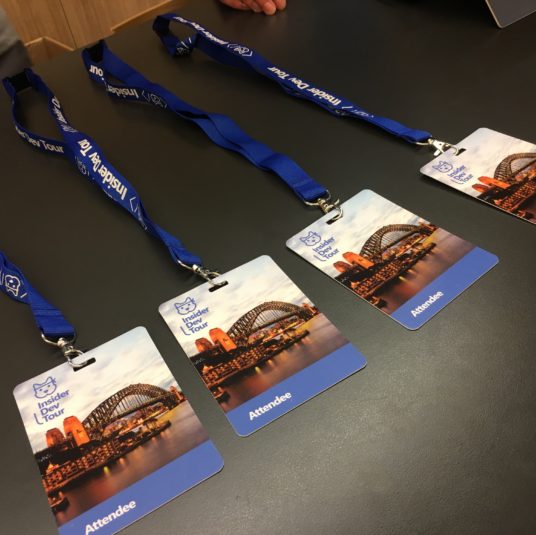The Insider Dev Tour grew out of the annual Microsoft Build conference in the US. This conference covers the latest things coming out of Microsoft and targets developers and the IT community.
Following the annual Build events, Microsoft have historically organised a global Build Tour event, usually staged in only a handful of cities and run by Microsoft corporate staff with local partners and individuals.
This year, though, Microsoft decided it was time for a fresh approach. Microsoft wanted to target a larger number of cities, with local communities working in conjunction with Microsoft corporate staff, but this time taking the lead.
And that was where Built to Roam came in.
The Sydney event
Built to Roam – and specifically Nick Randolph, a Microsoft MVP – took the lead in organising the Sydney Insider Dev Tour event attended by over 120 delegates. Additionally, Nick partnered with Microsoft’s Andrew Parsons to deliver the keynote address, and then went on to deliver two sessions – one on progressive web apps and the other on machine learning.
Not just another Cloud or Azure event
The event demonstrated the power of what’s possible with the Windows platform along with the parts of the Cloud that make sense for the Windows platform.
“The thing for us was that this wasn’t just another Cloud or Azure event,” says Nick Randolph. “A lot of the concepts are applicable in the cross-platform space, and this is what Built to Roam is all about – the cross-platform approach, building once for Windows, iOS and Android, for example.”
A breakdown of the content from the day highlights a key focus on Azure and Microsoft 365 – the two core pillars of Microsoft’s recent digital transformation. The keynote delivered an overview of how Azure is the cornerstone for modern applications and systems, providing the scalable backend for web, mobile and other edge computing scenarios. It went on to cover how Microsoft 365 is the next evolution of components such as Office 365 and Microsoft Graph; how Microsoft 365 includes application development technologies such as Progressive Web Apps and Modernising applications for Windows; and how Mixed Reality and Artificial Intelligence/Machine Learning are the next domains for innovation when it comes to native applications.
Following a quick morning break, Alec Tucker, a Microsoft MVP, provided an overview of how applications built with older technologies, such as Win32, WPF, WinForms, can be packaged for deployment on Windows 10 using the new packaging format, MSIX. Using the new packaging format allows older applications to start to take advantage of the new security context and features available on the Windows 10 platform. This was demonstrated by integrating Windows 10, that can leverage facial recognition, biometric or PIN security, into a WinForms application.
In the next session Nick covered building Progressive Web Applications (PWA) to deliver a cross-platform app-like experience in a web application. As a platform, Windows 10 can be used to light up a PWA, offering all the features available to a native application, whilst still retaining the ability to develop and deploy changes in the same way web developers are using today. PWAs today leverage a Service Worker to enable offline functionality and push notifications for an engaging app experience.
After lunch, Microsoft’s Dave Glover gave an amazing overview of connecting Azure functions, Azure Cognitive Services and Azure IoT Hub to custom hardware capable of running a Docker image. The session revealed how IoT has become accessible to every developer and that coupled with Azure it’s possible to develop solutions that can scale to a massive number of connected devices.
Next up, Cameron Dwyer, a Microsoft MVP, and Microsoft’s Andrew Coates took the attendees on a tour of some of the different ways developers can extend Office 365 and work with data made available via the Microsoft Graph. What’s often under-appreciated is that along with Office 365 comes the ability for applications, or extensions to Office products, to authenticate users and leverage the rich data made available via the Microsoft Graph. As new products are made available to Microsoft 365 subscribers, so too is the data available in the Microsoft Graph, providing an ever-expanding dataset from which applications can read and write data.
After a quick afternoon break, Nick returned to the stage to do a drill down into some of the offerings by Microsoft in the Artificial Intelligence and Machine Learning space. This is a massive area of innovation for numerous organisations, with the major cloud players such as Microsoft, Google and Amazon, leading the way. Microsoft has a number of services, published collectively as the Azure Cognitive Services, that are ready to use for application developers. One of these, the Custom Vision service, allows developers to create, train and publish Machine Learning models that can be exported for integration into IoT, mobile and desktop applications.
The last session of the day for the Insider Dev Tour was delivered by Lars Klint, a Microsoft MVP, and Microsoft’s Lawrence Crumpton, on building Mixed Reality applications. Microsoft has been a key innovator in the augmented, virtual and mixed reality space with their flagship product Hololens capturing the imagination of many developers. Whilst the mixed reality space is still in its infancy, Lars demonstrated how to get started using Unity and the Mixed Reality Toolkit to build applications for any of the commercially available headsets.
An amazing success
All the sessions went without a hitch, and Built to Roam received great feedback from delegates.
“Our aim is to be market leaders on this technology,” says Nick Randolph. “That’s why we’re presenting on it, so we can help to upskill others. We know and understand this space, which is why we organise and participate in these events so we can share our knowledge.”
If any of the topics from the Insider Dev Tour spark your imagination, check out Built to Roam’s capabilities and services, and then contact us to see how we can help.

